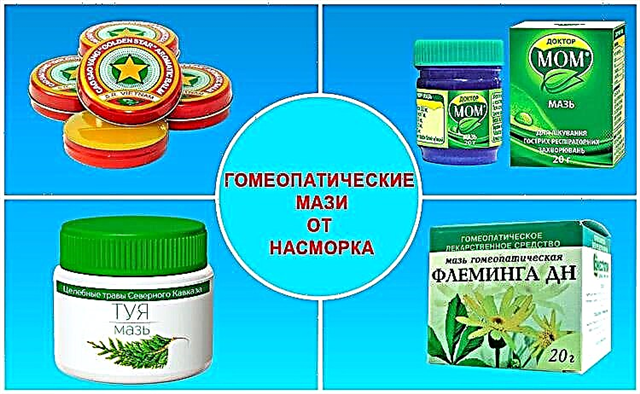 Therapeutic measures for microbial rhinitis should include systemic drugs (antibacterial tablets) and local drugs (aerosols, drops from green snot). The cause of a purulent rhinitis can be a primary bacterial infection or secondary, when the infection occurs against the background of a cold and immunodeficiency. In addition, in chronic sinusitis, the activation of opportunistic flora can be observed with an exacerbation of the disease.
Therapeutic measures for microbial rhinitis should include systemic drugs (antibacterial tablets) and local drugs (aerosols, drops from green snot). The cause of a purulent rhinitis can be a primary bacterial infection or secondary, when the infection occurs against the background of a cold and immunodeficiency. In addition, in chronic sinusitis, the activation of opportunistic flora can be observed with an exacerbation of the disease.
Symptomatically, infectious rhinitis is manifested by:
- nasal congestion;
- thick green discharge;
- hyperthermia;
- decreased sense of smell, taste;
- Difficulty nasal breathing.
The main objectives of therapy:
- eliminate pathogens;
- reduce tissue swelling, inflammation;
- ensure the outflow of purulent discharge;
- facilitate nasal breathing.
To this end, for local treatment, the doctor may prescribe the following nasal drops: saline; vasoconstrictor; mucolytic; antiseptic.
Saline solutions are used first, as medicinal drops are applied to the cleansed mucosa.
Saline solutions
With green snot, saline products are used to:
- moisturizing the mucous membrane;
- cleansing, protecting the mucous membrane;
- facilitating the outflow of purulent mucus;
- acceleration of regeneration.
There are several types of saline solutions that differ in salt concentration. A hypertonic solution, for example, Aqua Maris Strong, has a pronounced anti-edema effect. It makes it possible to facilitate the outflow of mucus by reducing tissue edema. As for the isotonic form (Humer, Marimer), solutions are used for prophylactic and therapeutic purposes to maintain the normal state of the nasal mucosa.
Vasoconstrictor drops
The action of vasoconstrictor drugs is aimed at reducing the severity of edema due to local vasospasm. It is not recommended to abuse such funds, as they reduce the production of mucus, which can aggravate the course of a purulent rhinitis. The discharge becomes thicker and may accumulate in the paranasal sinuses.
There are several types of drugs (depending on the composition and duration of the therapeutic effect):
- short-acting - Sanorin, Naphtizin, Vibrocil, Tizin;
- medium duration - Otrivin, Snoop, Farmazolin, Rinosprey;
- long-acting - Nazol, Fazin.
It is necessary to drip vasoconstrictor drugs, strictly observing medical recommendations. Among the contraindications, it is worth highlighting:
- glaucoma;
- violation of the cardiac rhythm;
- severe cardiac, renal pathology;
- pheochromocytoma;
- thyrotoxicosis;
- intolerance to the components.
Restrictions on child age, pregnancy period are individual for each drug.
Side effects include dryness, burning sensations in the nasal cavities, and nasopharyngeal tickling.
In case of an overdose, tremor, headache, irritability, increased blood pressure and insomnia are possible.
Mucolytic agents
 One of the main drugs in the treatment of green snot is a mucolytic. Due to its specific composition, mucus secretion increases, thereby diluting thick secretions. Purulent masses are not able to accumulate in the accessory cavities, since their outflow is facilitated, and the drainage function is restored.
One of the main drugs in the treatment of green snot is a mucolytic. Due to its specific composition, mucus secretion increases, thereby diluting thick secretions. Purulent masses are not able to accumulate in the accessory cavities, since their outflow is facilitated, and the drainage function is restored.
Rinofluimucil
The medicine belongs to the combined means. Its constituent components:
- reduce the severity of inflammation;
- increase the level of immune defense;
- liquefy purulent discharge;
- restore drainage function;
- strengthen the protection of the mucous membrane;
- reduce tissue edema.
The therapeutic course is 7 days, but the effect should be assessed on the third day. In the absence of positive dynamics, the doctor can change the treatment tactics. The drug does not enter the systemic bloodstream, therefore it has a minimal number of side effects.
Rinofluimucil is available in spray bottles. One press - one dose. Adults are prescribed two doses three times, after cleaning the inner surface of the nose with saline.
Among the side reactions, we highlight:
- an increase in the number of heartbeats;
- increased blood pressure;
- change in the psycho-emotional state (agitation, irritability);
- allergic reactions;
- addictive;
- dryness in the nasal passages.
Contraindications in adults include:
- hyperfunction of the thyroid gland;
- therapeutic course with antidepressants;
- glaucoma;
- drug intolerance.
As for childhood, Rinofluimucil is not recommended until two years of age. Care must be taken when treating people with bronchial asthma, cardiac arrhythmias, severe angina pectoris and hypertension.
In the treatment of pregnant women, the decision to use Rinofluimucil is made exclusively by the doctor based on the diagnostic data and the period of gestation.
Signs of an overdose include increased heart rate, increased sweating, tremors, and increased blood pressure.
You can enhance the effect of nasal drugs using the herbal medicine Sinupret. It can be used internally or inhaled.
Sinuforte
The drug has a herbal composition, namely the juice and the root of cyclomen. Its action is aimed at increasing the production of mucus, reducing the viscosity of purulent snot and facilitating their outflow. Thus, the drainage function and ventilation in the paranasal sinuses are restored.
Due to the regular cleansing of the nasal mucosa, microbes do not accumulate in the mucus and are not able to maintain the inflammatory process. Note that Sinuforte increases the effectiveness of nasal drops with an antibacterial composition (Bioparox, Isofra).
In addition to mucolytic and anti-inflammatory effects, the drug dilates blood vessels at the site of its administration. This helps to accelerate blood flow and facilitate the delivery of nutritional and immune components.
The duration of use of Sinuforte is two weeks. The drug can be used for chronic forms of otitis media, sinusitis and rhinitis.
Contraindications include:
- age up to five years;
- severe cardiovascular disease;
- allergic reactions;
- simultaneous administration with vasoconstrictor intranasal agents;
- pregnancy.
 The daily dose is one spray in each nasal passage. Do not forget to pre-clean the mucous membrane with saline products. After the administration of the drug, an increase in salivation, lacrimation, baking sensations in the nasopharynx, the appearance of skin rashes and shortness of breath are possible. All these signs indicate an allergic reaction to the components of Sinuforte.
The daily dose is one spray in each nasal passage. Do not forget to pre-clean the mucous membrane with saline products. After the administration of the drug, an increase in salivation, lacrimation, baking sensations in the nasopharynx, the appearance of skin rashes and shortness of breath are possible. All these signs indicate an allergic reaction to the components of Sinuforte.
Particular attention should be paid to dosages and duration of the course, since the plant is considered toxic.
Antiseptics and antibiotics
In the treatment of purulent rhinitis, antibacterial drops cannot be dispensed with. They are necessary to suppress the vital activity of pathogenic pathogens, prevent the production of toxic substances, as well as complete sanitation of the infectious focus.
Protargol
The drug contains silver proteinate.After its application, a protective film forms on the nasal mucosa. The active ingredients kill old germs and prevent new infections.
In addition, the drug has a vasoconstrictor effect, which makes it possible to reduce tissue swelling, mucus volume and facilitate nasal breathing. Against the background of treatment with Protargol, the injured tissues heal much faster.
The medicine can be used prophylactically to prevent exacerbation in chronic infectious diseases of the nasopharynx.
Contraindications include:
- glaucoma;
- severe atherosclerotic vascular disease;
- hypertonic disease;
- cardiopalmus;
- hyperfunction of the thyroid gland;

- atrophic type of rhinitis.
There are age restrictions for using a 0.1% solution (up to six years). In addition, caution in treatment should be observed in people with diabetes mellitus, prostate hypertrophy, uncontrolled angina pectoris.
For therapeutic purposes, the drug is prescribed three drops three times. When applying a 0.05% solution, infants are recommended to bury the nasal passages one drop at a time three times.
In exceptional cases, after instillation of the nose, redness of the mucous membrane and itching sensations may occur. Failure to comply with the recommended doses may cause dryness, burning of the mucous membrane. Sneezing and increased nasal discharge may also occur.
In case of an overdose, it is noted:
- vomit;
- headache;
- visual dysfunction;
- increased swelling of the nasal mucosa;
- increased blood pressure;
- violation of the cardiac rhythm;
- insomnia;
- change in the psycho-emotional state (irritability, anxiety, tearfulness).
Miramistin
Miramistin belongs to antiseptics with a wide spectrum. Due to its high efficiency, it is widely used in urogynecology, otolaryngology and surgery.
The drug is absolutely safe, therefore it can be used for pregnant women and babies.
In addition to the antimicrobial effect, there is an anti-inflammatory and regenerative effect. The drug can be used for complicated bacterial and fungal rhinitis.
Bury the nasal passages 2-4 drops three times a day. For a baby, you need to dilute the medicine with boiled water (1: 1). Among the side reactions, we single out itching sensations, tissue edema and dryness in the nasopharynx.
Polydexa
Isofra, Bioparox have a powerful antimicrobial effect, which contain one antibacterial component each, as well as Polydex (a combination drug). Let's describe the last drug in more detail.
Polydexa consists of antibacterial (polymyxin B, neomycin), hormonal (dexamethasone) and vasoconstrictor (phenylephrine) components. Thus, the drug:
- reduces inflammation;
- reduces tissue edema;
- facilitates the outflow of mucus;
- eliminates germs.
Polydexa is ineffective for anaerobic infections, as well as diseases caused by the activity of staphylococci and pneumococci. The drug is contraindicated:
- with drug intolerance;
- with subcompensated renal insufficiency;
- with glaucoma;
- in the active stage of viral diseases;
- under the age of 2.5 years.
The drug is prescribed in one dose four times a day. Drip administration of medicinal solutions is only part of local therapy. In addition, you should regularly rinse the nasal cavities, as well as take antibiotic tablets. Treatment should be carried out under medical supervision, as there is a high risk of developing sinusitis.
With the accumulation of purulent discharge in the paranasal cavities, fever increases, nasal congestion increases, and the general condition worsens. This can be a reason for puncture of the paranasal sinuses for aspiration of pus and sanitation of the infectious focus.




